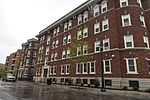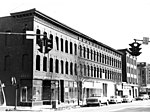South Main Street School
National Register of Historic Places in Springfield, MassachusettsSchool buildings on the National Register of Historic Places in MassachusettsSchools in Springfield, Massachusetts

The South Main Street School is an historic school building at 11 Acushnet Avenue in the South End of Springfield, Massachusetts. Built in 1895, it is a good local example of Renaissance Revival architecture, and a major work of local architect Francis R. Richmond. It served as an elementary school into the 1970s, and has been converted to residential use. The building was listed on the National Register of Historic Places in 1985.
Excerpt from the Wikipedia article South Main Street School (License: CC BY-SA 3.0, Authors, Images).South Main Street School
Acushnet Avenue, Springfield
Geographical coordinates (GPS) Address External links Nearby Places Show on map
Geographical coordinates (GPS)
| Latitude | Longitude |
|---|---|
| N 42.091944444444 ° | E -72.579444444444 ° |
Address
Acushnet Avenue 11
01105 Springfield
Massachusetts, United States
Open on Google Maps








